
Midnight Club II is a 2003 racing video game developed by Rockstar San Diego and published by Rockstar Games. It is the sequel to Midnight Club: Street Racing, published for the PlayStation 2, Xbox and Microsoft Windows and first in series to feature motorcycles. Players can race through cities based on Los Angeles, Paris, and Tokyo. The game also features an online multiplayer component. It is the second game in Midnight Club franchise, followed by Midnight Club 3: DUB Edition.

TimeSplitters 2 is a first-person shooter video game, developed by Free Radical Design, published by Eidos Interactive, and released in 2002 for PlayStation 2, Xbox and GameCube. The game's story focuses on the efforts of a space marine who seeks to recover powerful time crystals from a race of alien mutants called TimeSplitters, which leads them to taking on the form of an individual dealing with their own problems across different time periods between the 19th and 25th century. The developers focused on expanding the story element following 2000's TimeSplitters, and features influences from various film genres, including Horror, Action and Science Fiction.

Driver 3 is a 2004 action-adventure game, the third installment in the Driver series. It was developed by Reflections Interactive, published by Atari, and released on PlayStation 2, Xbox and mobile phones in June 2004, Microsoft Windows in March 2005, and Game Boy Advance in October 2005. The game's story focuses on players assuming the role of John Tanner, an undercover FBI agent, as he investigates a car-smuggling ring across three countries, in order to identify and arrest its boss and learn who they are planning to sell a cache of stolen cars to. The game expanded upon its predecessors with on-foot sections, gun combat, and drive-by shooting, with virtual recreations of three major cities - Miami, Nice, and Istanbul - free-roam game mode, and an improvement to the series' film-making "director mode".

Red Faction II is a first-person shooter video game developed by Volition and published by THQ for the PlayStation 2, GameCube, Windows and Xbox. It is the sequel to Red Faction and the second installment in the Red Faction series. The game changed the direction of the first game by introducing a greater emphasis on action and a new setting on Earth, rather than Mars.

Need for Speed: Underground is a 2003 racing video game and the seventh installment in the Need for Speed series. It was developed by EA Black Box and published by Electronic Arts. Three different versions of the game were produced: one for consoles and Microsoft Windows, and another for the Game Boy Advance. An arcade version was additionally developed by Global VR, and was published by Konami with assistance from Electronic Arts.

Need for Speed: Hot Pursuit 2 is a 2002 racing video game, the sixth installment in the Need for Speed series and the sequel to 1998's Need for Speed III: Hot Pursuit. It was developed by EA Black Box for the PlayStation 2, and by EA Seattle for GameCube, Xbox, and Microsoft Windows. It features cars from various high-performance and exotic car manufacturers. Players can compete in races using these cars, or opt to play as a police officer and pursue speeders.

Burnout is a 2001 racing video game developed by Criterion Games and published by Acclaim Entertainment for the PlayStation 2, GameCube and Xbox.

Burnout 3: Takedown is a 2004 racing video game developed by Criterion Games and published by Electronic Arts. It is the third instalment in the Burnout series, which is characterised by fast-paced arcade racing. A staple of the series is the use of boost, earned through risky driving, to rapidly increase a car's speed. The central mechanic introduced in Burnout 3 is Takedowns, which allow players to slam their opponents until they crash. Takedowns work in conjunction with the boost system by filling up and extending the boost meter. Aside from standard circuit races, the game features modes focused on performing Takedowns on rival vehicles and causing monetary damage at a junction occupied with traffic. Each game variant is featured in a single-player campaign mode called World Tour, which serves as the primary method for unlocking new and faster cars. The game supports both online and split-screen multiplayer.
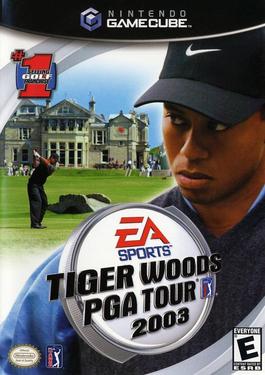
Tiger Woods PGA Tour 2003 is a sports video game developed by EA Redwood Shores for the Xbox, PlayStation 2 and GameCube versions and Headgate Studios for the Microsoft Windows and Mac OS versions and published by EA Sports.
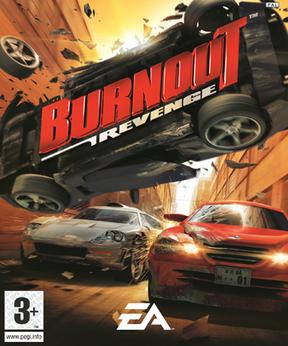
Burnout Revenge is a 2005 racing video game developed by Criterion Games and published by Electronic Arts for PlayStation 2, Xbox and Xbox 360.

Auto Modellista (アウトモデリスタ) is a racing game developed and published by Capcom, first released on PlayStation 2, later ported to GameCube and Xbox.
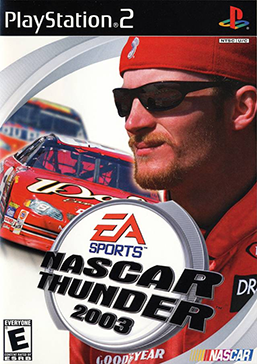
NASCAR Thunder 2003 is the sixth edition of the EA Sports' NASCAR racing simulator series. Developed by EA Tiburon and Budcat Creations and published by EA Sports. It was released for PlayStation, PlayStation 2, GameCube, and Xbox on September 18, 2002, and for Microsoft Windows on October 21. The product features Dale Earnhardt Jr. on the cover. It was the first time the NASCAR's Most Popular Driver Award recipient was featured on the cover, although he did not win the award for the first time until the following year. Dale Earnhardt appeared in the game as a driver as a result of entering his name as a Create-A-Car driver's name; he did not appear in the previous game due to his death. He appeared as a legend in subsequent games.
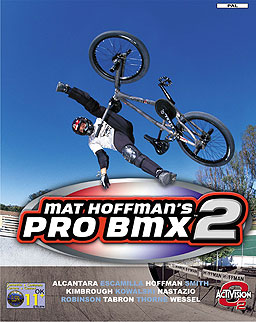
Mat Hoffman's Pro BMX 2 is a BMX video game endorsed by Mat Hoffman and published by Activision under the Activision O2 label. The game, which serves as a sequel to Mat Hoffman's Pro BMX, was released on August 13, 2002 for the PlayStation 2 and Xbox. A Game Boy Advance port was developed by HotGen and released the same day as the PlayStation 2 and Xbox versions. A GameCube port was developed by Gratuitous Games and was released on October 8, 2002.

Street Racing Syndicate is an open world multiplatform racing video game produced by Eutechnyx, and released by Namco on August 31, 2004, for the PlayStation 2, GameCube, Xbox and Windows-based personal computers. The game was also released for the Game Boy Advance on October 4, 2005. During its release, it was meant to compete against Need for Speed: Underground 2, the sequel to the critically acclaimed first game released in 2003.

TOCA Race Driver 2 is a racing video game developed and published by Codemasters for Xbox, Windows, PlayStation 2, Mobile and PlayStation Portable. It is the fifth game in the TOCA series.

V-Rally 3 is a racing video game developed by Eden Studios and published by Infogrames Europe. It was released for the PlayStation 2 and Game Boy Advance platforms in 2002, and ported to the Xbox, GameCube, and Microsoft Windows in 2003.

Burnout Dominator is a 2007 racing video game developed by EA UK and published by Electronic Arts for PlayStation 2 and PlayStation Portable. It retains the core gameplay of the series, as players race at top speeds through dozens of World Tour events testing "reckless skill-based" driving techniques.
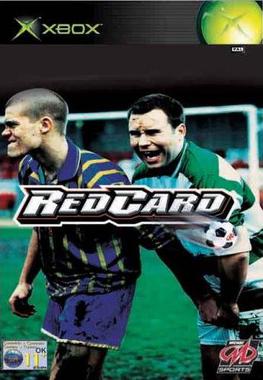
RedCard 2003, known as RedCard in Europe, is a video game based on association football, released in 2002 by Point of View. The game follows most of the rules of football, but allows for heavy tackles and special moves once the player has charged up a special meter.

Rocky is a fighting video game published by Rage Software and released in 2002. The game is based on the Rocky franchise.

IndyCar Series is a racing simulator developed by Brain in a Jar and published by Codemasters. The game was released in 2003 for PlayStation 2, Xbox, and Windows. The game is based on the 2002 Indy Racing League. A sequel to the game, IndyCar Series 2005, was released in 2004 for PlayStation 2, Xbox, and Windows based on the 2003 IndyCar Series.



















